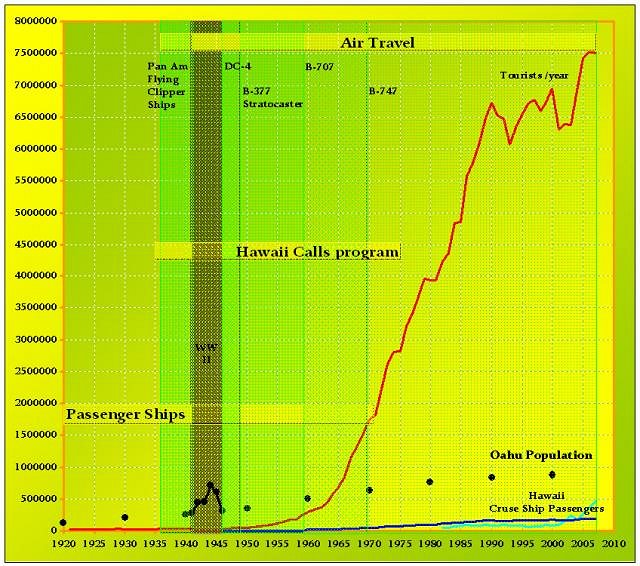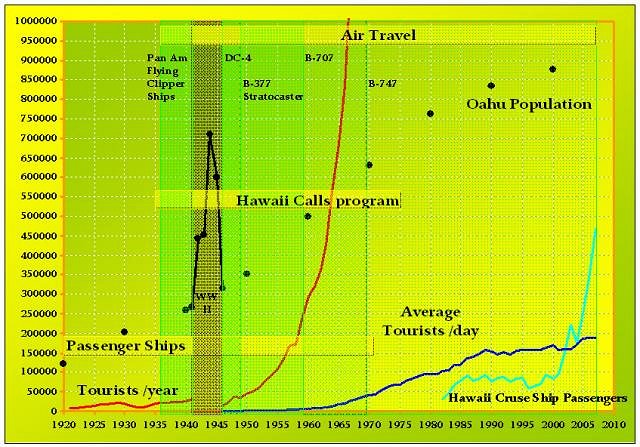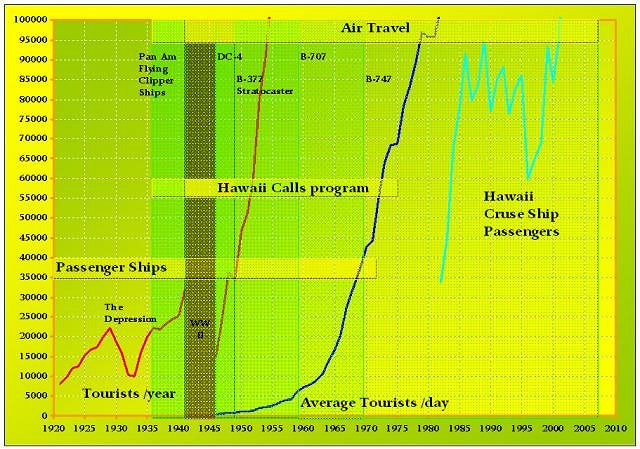Tiki Central / General Tiki / Webley Edwards/Hawaii Calls Biography
Post #470720 by allenroyboy on Tue, Jul 21, 2009 4:05 PM
|
A
allenroyboy
Posted
posted
on
Tue, Jul 21, 2009 4:05 PM
In my biographical research of Webley Edwards and Hawaii Calls, the influence of Hawaii Calls on the Hawaiian tourist industry is often mentioned by old time listeners of the program. To see if I could verify those claims, I collected Hawaii tourist data through 2007 from the on-line visitor statistics available from the Hawaii Department of Business, Economic Development and Tourism ( http://hawaii.gov/dbedt/info/visitor-stats/HAWAII_HISTORICAL_2007.xls ). I plotted the data on the three graphs presented below along with information I gathered about the means of transportation to Hawaii over the years. The graphs are the same data presented in 3 different vertical scales of visitors per year to Hawaii—8,000,000; 1,000,000; and 100,000. Each graph emphasizes important aspects of the data. The first shows the growth of tourist numbers to Hawaii. The second puts things in context to the population of Oahu. And the third emphasizes the early years of tourism. Graph 1 As can be seen the means of transportation has had a vast influence over the numbers of tourists to Hawaii. Before WWII nearly all tourism was by ship. The Pan Am Clipper Ships had a negliable influence, but they signal a massive change to come. After the war, DC-4s were the primary air travel means, but even then the influence was small. However, there was a huge difference in price between ship and air travel in favor of planes. The introduction of B-377 Stratocaster planes by Pan Am in 1949 with even cheeper air fare signaled the boom on tourists to Hawaii. With the introduction of the B-707 in 1959 and the B-747 in 1969 travel by ship was doomed and the number of visitors to Hawaii soared. Graph 2 The population of Oahu (according to US Census) has gone from about 130,000 in 1920 to about 870,000 in 2000. While this is a fairly large increase, compared to the more than 7,000,000 tourist per year it does not seem all that much. It is interesting to note that the population on Oahu during WWII in 1944 was not equaled until the mid 1970s. Another interesting line is the average tourists per day. It runs at something like 18% of the population. However, the number of average tourists per day today has almost reached the level of the island population in 1930. Graph 3 How much the Great Depression and WWII affected tourism can be clearly seen on graph 3. Also, the maximum number of ship passengers appears to be in about 1949. (There is no data that shows the breakdown between ship and airline numbers during this time so the decrease in ship passengers that lead to the demise of passenger ship service to Hawaii in the early 1970s is not apparent.) It is very interesting to note the passenger numbers for cruise ships to and around Hawaii beginning in about 1982. They start out with about the same passengers per year as at the height of the early passenger service and then boom off the chart. By 2007, as seen on graph 2, the number of cruise ship passengers had nearly reached the entire population of Oahu back in 1960. Now, to the question of the influence of Hawaii Calls on tourism. It is very apparent that the numbers of visitors to Hawaii has been controlled by the means of transportation to Hawaii. However, what was it that demanded the need for better and cheaper transportation? This is not clear at all from this data. And it is apparent from other research I conducted so far that Hawaiian visitor bureaus over the years have been very aggressive in wooing tourist to Hawaii. Hawaii Calls was a part of that advertising being paid for by the tourist bureaus (funded by the government). Whether Hawaii Calls was a major player in drawing tourists to Hawaii remains to be seen. The program was very big before the rise of TV. Then, beginning about the 1960s, its popularity dwindled down to nearly nothing by the end of its run in 1975. It may be argued that the program was the major influence for tourists who remember listening to the program on radio in mid winter with minus 20 temps and a wind chill factor of another 30 degrees. But with the rise of TV and the shift in radio programming to popular and rock and role music, the relevancy of the program was lost. It may not be possible to truly measure the influence of Hawaii Calls, but to those who used to listen to it long ago, it is an irreplaceable, indelible memory. [Correction: It should read on the graphs B-377 STRATOCRUISER. ] [ Edited by: allenroyboy 2009-07-22 07:35 ] |



